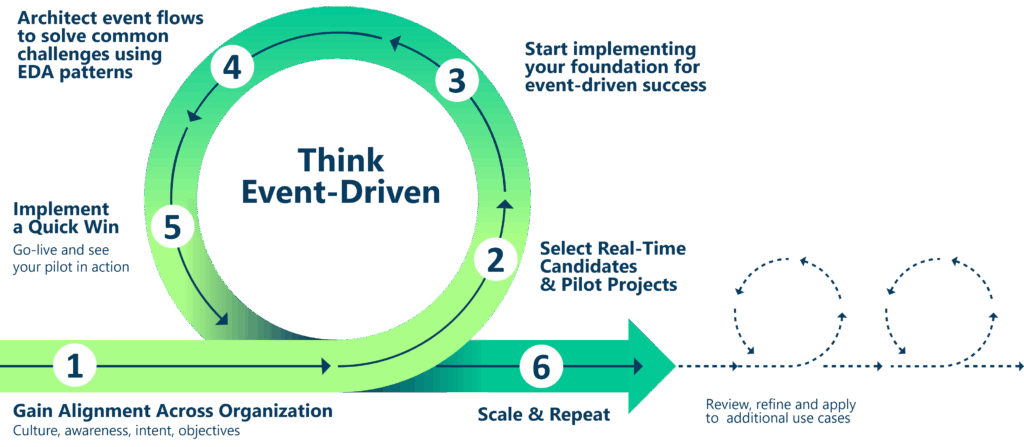Businesses run on moments — orders being placed, prices changing, sensor readings hitting threshholds, etc. We call these moments “events,” and your success depends on your ability to detect and react to them as quickly as possible.
The key to doing so is building your system in such a way that applications, AI agents and edge devices interact in real-time as events occur, known as event-driven architecture (EDA). You can implement and benefit from EDA on a project-by-project basis—improving the responsiveness or resilience of individual applications and processes—but it becomes truly transformative when you adopt it across your organization.
Think Event-Driven is Solace’s proven playbook for seizing the strategic opportunity that EDA presents so you can leave behind brittle, centralized integration and take an event-first approach that decouples systems, treats events like products, and handles integration at the edge.
Benefits
- Faster time to market for integrations and AI features.
- Reduced complexity and operational risk.
- Higher reuse and lower cost per integration through micro-integrations and catalogs.
- Real-time inputs for AI and agentic systems for better decisions and automation.
Solace’s Approach
We believe that to put in place an integration infrastructure that meets your needs today and as agentic AI transformations every area of every business, you need to do four things:
- Liberate: Unlock siloed data from your legacy apps, cloud services and IoT devices by letting them send updates as things happen.
- Stream and Filter: Distribute that data in real-time across environments and geographics so all of your apps, agent and device get exactly—and only—the information they need.
- React: Let your apps, agents, and people analyze and immediately act on it by sending events of their own.
- Democratize: Give your team self-service access so they can share, reuse and govern events, event streams, event APIs, etc.
We provide a powerful set of tools you can use to do all of that called Solace Platform, which as you’d expect pairs perfectly with Think Event-Driven.
The “Think Event-Driven” Implementation Methodology
For your enterprise to be real-time, information must be streamed between the applications, agents and devices that generate and process it so insights can be gleaned and decisions can be made – fast. To become more responsive and to take advantage of new technologies like AI, cloud, IoT and microservices your architecture needs to support real-time, event-driven interactions.
Every business process is basically a series of events, or notifications that something has happened or changed. Event-driven architecture (EDA) is a way of building enterprise IT systems that lets applications and AI agents produce and consume these events.
Implementing EDA is a journey, and like all journeys it begins with a single step. To get started down this path, you need to have a good understanding of your data, but more importantly, you need to adopt an event-first mindset.
That’s why the approach shown here and described below is called “Think Event-Driven.” With this proven playbook, you will be on your way to securing stakeholder engagement, seeing initial success, and transforming your entire organization.
1: Gain Alignment
EDA generally starts small and scales over time, but it’s important to get key stakeholder to embrace event-first thinking early on. This requires some thought leadership to get buy-in.
It’s important to educate yourself so you can educate stakeholders about the benefits of EDA: agility, responsiveness, and better customer experiences. Build support, strategize, and ensure that the next project – the next transformation, the next microservice, the next API – will be done the event-driven way.
2: Identify Candidates for Real-Time
Not all systems need change or can be changed to real-time, but most will benefit from an event-driven approach. You’ve probably already thought about a bunch of processes and projects, APIs and AI agents, that would benefit from being real-time. But what are the best candidates in your enterprise?
Find a system that has robust data generation capabilities and can be easily modified to submit messages. These messages will be harnessed as your events later in the journey.
3: Build Your Foundation
Once you’ve identified your first project, it’s time to think about architecture and tooling. It’s important to start the design-time right, and have the tooling to ensure that events can be described and cataloged, and have their relationships visualized.
For this you’ll need an event-driven integration platform that enables data distribution via an event mesh, micro-integrations to connect apps and agents at the edge, and an event portal to give architects, developers and stakeholders self-service access to reuse and govern event-driven apps, APIs and other assets.
4: Design the Flow for your Project
An event flow is the way an event is generated, sent through your broker, and eventually consumed.
With each project, as you identify events and the event flow, the event catalog will start taking shape, making events discoverable and so other applications can consume them off the event mesh.
You want to choose a flow that makes sense for your current state modernization or pain reduction. An inflight project or an upcoming transformation make ideal candidates, whether it’s for innovation or technical debt reduction via performance, robustness, or cloud adoption.
5: Develop and Deploy Event-Driven Elements
Once pilot flows have been identified and an initial event catalog is starting, the next step is to start an event-driven design by decomposing the business flow into event-driven microservices and agents, and identify events in the process.
Decomposing an event flow reduces the total effort required to ingest event sources, as each microservice or agent will handle a single aspect of the total event flow. New business logic can be built using microservices, while existing applications – SAP, mainframe, custom apps – can be event-enabled with adapters.
6: Scale and Repeat
Once the design is done and the first application gets delivered as an event-native application, the event catalog also starts to get populated.
Getting a quick win with the event catalog as a main deliverable is just as important as the other business logic, and it drives innovation and reuse.
Hopefully, with the ability to do more things in real-time, you can demonstrate agility and responsiveness of applications, which in turn leads to a better customer experience. With stakeholder engagement, you can help transform the whole organization!
Frequently Asked Questions
Q: How long does it take to see success with Think Event-Driven?
Q: What’s the easiest way to learn how to implement Think Event-Driven?
Q: How can I evangelize Think Event-Driven across my organization?
Q: Does Solace offer Think Event-Driven as a service?
Get Started Today!
The Architect’s Guide to Implementing Event-Driven ArchitectureOur CTSO Sumeet Puri's deep-dive guide that breaks down how to implement EDA using the Think Event-Driven methodology complete with use case examples, sample topics, and more.Read the Whitepaper


